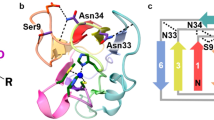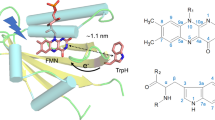Abstract
THE blue copper-proteins are characterized by very intense optical absorption near 600 mµ and unusually low cupric hyperfine splitting (A∥) as observed by electron paramagnetic resonance. The nature of the copper-protein binding and the relationship between the colour and the electron paramagnetic resonance spectrum, while the subject of much investigation and speculation, have remained obscure1–4. However, almost all investigations have centred on ceruloplasmin and laccase, which contain eight and four atoms of copper per protein molecule, respectively, with only about half this number in the cupric state. It seemed, therefore, that these two proteins are not best suited for further investigation, particularly since it has been shown that blue proteins which contain only one cupric ion per molecule also have intense optical absorption near 600 mµ and small A∥ values5,6. It was with the foregoing in mind that an investigation of the blue protein from Pseudomonas aeruginosa was undertaken. This protein has a broad absorption with a maximum at 625 mµ (molar extinction coefficient of approximately 2,000) and an A∥ value of 60 × 10−4 cm−1. The protein was isolated according to the method of Horio7, with some modifications, and investigated in solution at room temperature and in frozen solution at −160° C by optical, electron paramagnetic resonance and optical rotatory dispersion methods.
This is a preview of subscription content, access via your institution
Access options
Subscribe to this journal
Receive 51 print issues and online access
$199.00 per year
only $3.90 per issue
Buy this article
- Purchase on Springer Link
- Instant access to full article PDF
Prices may be subject to local taxes which are calculated during checkout
Similar content being viewed by others
References
Broman, L., Malmström, B. G., Aasa, R., and Vänngård, T., J. Mol. Biol., 5, 301 (1962).
Blumberg, W. E., Eisinger, J., Aisen, P., Morell, A. G., and Scheinberg, I. H., J. Biol. Chem., 238, 1675 (1963).
Kasper, C. B., Deutsch, H. F., and Beinert, H., J. Biol. Chem., 238, 2338 (1963).
Brill, A. S., Martin, R. B., and Williams, R. J. P., in Electronic Aspects of Biochemistry, 519 (Academic Press Inc., New York, 1964).
Mason, H. S., Biochem. Biophys. Res. Commun., 10, 11 (1963).
Blumberg, W. E., Levine, W. G., Margolis, S., and Peisach, J., Biochem. Biophys. Res. Commun., 15, 277 (1964).
Horio, T., J. Biochem. (Tokyo), 45, 195 (1958).
Ulmer, D. D., and Vallee, B. L., Biochemistry, 2, 1335 (1963).
Author information
Authors and Affiliations
Rights and permissions
About this article
Cite this article
MARIA, H. Colour, Magnetic Resonance and Symmetry of the Cupric Site in Blue Protein. Nature 209, 1023–1024 (1966). https://doi.org/10.1038/2091023a0
Issue Date:
DOI: https://doi.org/10.1038/2091023a0
Comments
By submitting a comment you agree to abide by our Terms and Community Guidelines. If you find something abusive or that does not comply with our terms or guidelines please flag it as inappropriate.



